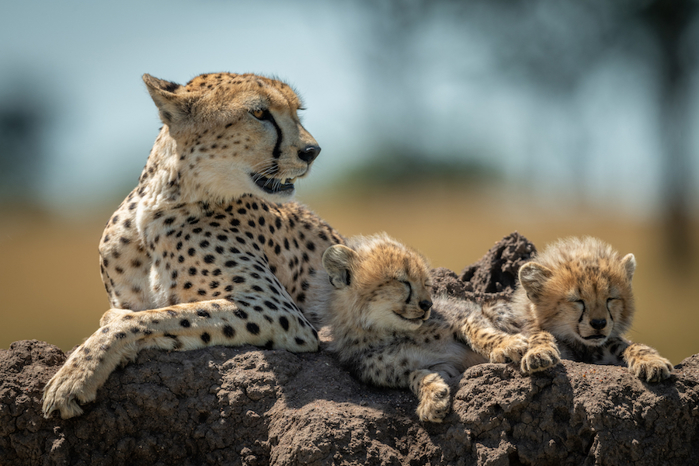
How does inbreeding affect the immune system of animals?
July 13, 2005

- Related Topics:
- Intermarriage,
- Genetic variation,
- Population genetics
A curious adult from Australia asks:
"How does inbreeding affect the immune system of animals?"
Some inbred strains of mice need to be kept in a sterile environment, and a single virus could wipe out the cheetah or Florida panther. All because inbreeding has so weakened these species' immune systems.
Why has inbreeding made these animals so sickly? Part of the reason is the lack of variety in their MHC (or Major Histocompatibility Complex) genes.
Genes and the Immune System
One of the immune system's jobs is to recognize and destroy invaders like bacteria and viruses. The MHC genes are important for the recognition part of this process.
Our immune system recognizes invaders by looking for markers on their outsides. You can think of this as identifying the enemy because of their uniform -- sort of like the way the American colonial army identified the British redcoats.
Of course, cells don't wear uniforms. But they do have markers on their outsides called antigens. Each cell type, bacteria, virus, etc. has different antigens.
The MHC genes are important for recognizing foreign markers. Once identified, the foreign markers are then shown to T-cells. The T-cells then get the B cells all excited and together, they eliminate the invader.
As you can imagine, there are a huge number of ever-changing markers out there, and each MHC gene can only recognize a few markers. So to pull this off, we have lots of different kinds of MHC genes. And most important for our discussion here, each MHC gene comes in lots of different forms.
It is this variety in MHC genes that gives a species its ability to fight off most invaders. Imagine that we each have one MHC gene that comes in one flavor. That means as a species, we could ward off a few bacteria, and maybe a virus or two.
Now imagine that the one MHC gene comes in 5 versions. Now we can get 5 times as many bacteria and viruses. If we have 2 MHC genes and each has 5 versions, we get to 225 times the number of antigens.*

Inbreeding and the Immune System
Humans have hundreds of MHC genes, some of which have over 400 different forms. This is where we get the incredible diversity of our immune systems, and why we can survive the daily onslaught of foreign invaders.
Inbred species are more like our first examples. They have the same form of many of their MHC genes (or all of them, in the case of lab mice). This means that they can't fight off a lot of what Mother Nature throws at them.
And even worse, a single virus or kind of bacteria could wipe out a species. In a less inbred population, some individuals will have the right combination of MHC genes to thwart the invader. A lot of the group will become sick, but enough will survive to keep the species going.
But this isn't the case for an inbred species. Because they share so many of the same forms of the MHC genes, they could all be vulnerable to a single virus. This is one of the big fears with some endangered species like Florida panthers or the cheetah.
But all is not lost for these animals. An inbred species can prosper if it gets lucky. If it doesn't encounter any bugs that kill it off, the species may get stronger through a natural process of DNA change (mutations). As more forms of the MHC genes arise through these mutations, the species will become resistant to lots of different bacteria and viruses.
This is probably how our incredibly diverse immune system developed over time. And why we can tackle many bugs we've never even seen before. Inbreeding is definitely something to be avoided if a species wants a strong immune system.
*The math
The 225 comes from the fact that we have 2 copies of each of our genes. So if we have 2 genes and 2 possible copies of each you get a total of 4.
Let's say gene 1 comes in 5 forms, A,B,C,D, and E. Gene 2 comes in 5 forms as well--F,G,H,I, and J.
Let's start out with the AA combination for gene 1. What are the possible combinations of gene 2 that can go with AA?
There are 15:
FF GG HH II JJ
FG GH HI IJ
FH GI HJ
FI GH
FJ
The same is true for all the possible combinations of gene 1 which are:
AA BB CC DD EE
AB BC CD DE
AC BD CE
AD BE
AE
So, you multiply the two numbers together, 15 X 15 and you end up with 225.

 Skip Navigation
Skip Navigation
